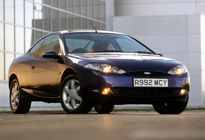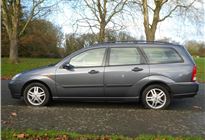Ford Fiesta Mk2 (1983 - 1989)

1.1 Holiday 5 speed non-cat Magenta
Bought as a budget car over a year ago and has proven to be so reliable and economical it will be hard to let it go
I've only owned the car for just over a year and I will update in later years as it seems I will be owning it for quite a while (hopefully). The picture above isn't mine but is pretty much what the car looks like (when it was new). It was bought as a budget car mostly because it ticked all the boxes of being:
1. (Very) cheap to insure - qualified for classic insurance which was £500 or 80% cheaper per year than similar small cars that weren't classics (includes fiesta mk3).
2. Reasonably cheap to tax at £145/yr.
3. Good on fuel - allegedly 45.6mpg in the city according to official tests, but 40 has been more the mark (not complaining), and I've observed almost 60mpg over 330 miles from Chatham to Derby and back doing ~60mph.
4. Small - it is <12ft long and barely over 5ft wide so I can park easily.
5. cheap and easy to fix - servicing and fitting battery can be done by myself, I've fitted replacement windows, battery and lights myself too.
6. Simple - no ECU, cat, little creature comforts to go wrong
7. Cheap to buy - Got it with 12 months mot, 6 months tax, Thatcham approved security lock, <67,000 miles and half a tank of petrol for £500.
8. Going up in value as a rare future classic - easily worth £1000 now with a new mot and work done to it.
9. Replacement parts still abundant and cheap to buy. Out of what I have bought and got quotes for include replacement front windscreen including fitting for £100 (didn't need in the end), replacement indicator light and cover £5, replacement front bumper £12, replacement rear light cluster £10, replacement tires 6-8mm tread part worn £12 a corner including fitting (not needed yet) replacement corner door window including rubber £8. New Bosch battery with 4 years warranty £30.
10. It's reasonably practical with seats and belts for 4 adults with a reasonable amount of luggage space.
11. The boot aperture is a good size for loading with stuff when back seats are down. I've had so much flat pack furniture in it and a massive reclining arm chair in it. The loading height is pretty low too (total height of car is only 1.33m).
12. Timing chain lasts life of vehicle so no snapping cam belts to worry about either. Mine has done 71,000 and isn't noticeably rattling yet.
Reliability:
Over the year the only time it has let me down was because of the previous battery during the cold winter. It wouldn't start because the cranking power was too low according to the breakdown guy (covered by my insurance add on) it was over 4 years old, the calcium technology (not lead acid) and not a very good make. The car started after 3 seconds cranking from his battery, and after fitting the new Bosch battery has been fine since.
Replacing parts:
The other replacement parts were for periodic servicing and the rest because of my own stupidity reversing into something and 2 people reversing into me and damaging my front bumper and breaking my lights. I also had to fit a new driver side corner window because I left the keys in my car!
Safety:
It's not a safe car in terms of coming off well in a crash with other vehicles, but then even a 1986 Volvo isn't by today standards. The total width of the door is thin with little distance from the seat so a side impact on the drivers side could be tragic! So if safety is a priority then avoid. For this reason most of the driving it in the city up to 30mph and I don't do more than 65mph on motorways.
Performance:
Being a 1117cc non-cat engine, it developed 50bhp at 5000rpm and 61ft.lbs of torque at 2700rpm in 1986. I don't know what it is now but I doubt may horses have escaped. It is very slow when full of stuff or 3+ adults in it. It is just about OK with one adult and light luggage, thanks to most of the torque being from 1500rpm and a curb weight of 750kg. It will happily potter about in top gear at 30mph too. Engine seems to be happy and pull well from 1400rpm in any gear.
Refinement:
It starts to get noticeably noisy above 45mph, with virtually no wind and engine sound deadening. This is helped a bit by the 22.2mph/1000rpm 5th gear, so forget the 4 speed 957cc car as that is 17mph/1000rpm which is less economical, very low on power and stupidly noisy at motorway speeds.
Ride quality is just about OK over most road surfaces, you will notice almost any bump though.
It's drag coefficient is also quite high at 0.40, but its small dimensions mean overall drag is comparable to a mid size car of 0.30. Basically expect mpg to plummet at speeds above 60mph, to the extent that at 70mph the 1.4 or 1.6 would be just as fuel efficient and the better choice.
Driving:
Brakes are not confidence inspiring and they take some getting used to after getting out more modern cars. The clutch is light and the spacing of pedals has never been an issue for me. The gearshift is typical old car 'notchy' with long throws, however engaging reverse is OK and shifting is not bad enough that you will select 4th instead of 2nd.
Interior:
The dash arrangement is old school and pretty clear with the obvious gauges. Could do with numerical markings for the engine temperature though. The interior quality is a mixed bag, with tacky plastics, especially the door pockets being offset by reasonably comfortable and hard wearing fabric seats. After 29 years and 71,000 miles the seats have no tears whatsoever.
Tires:
Tyre width is stupidly low by today's standards - 135mm. You get wheel spin in the rain in 3rd gear up a reasonable incline it is embarrassing!
Starting up:
The manual choke is good for starting in any weather, in the summer a very small amount is required, but the car is a carburetor with no cat so after starting even when tuned up you can smell the petrol - probably kills city mpg by 10%!
Entertainment:
The radio is original factory fitted but dodgy wiring from it to the speakers means there has been no music after 9 months ownership. Factory fitted cassette still works after 29 years too.
Build quality:
The door mirrors start to shake on the motorway but that may be just loose mounting.
Rust is killing it - needed £350 of welds for mot, but that was it. Wings are still cheap (£40 for a new one) but apparently need to be welded on so I can't be bothered.
Niggles:
Oh and the petrol filler cap could do with being attached to the car like most modern vehicles - I left it on the roof and it fell off so had to replace with 2 sets of keys £10 delivered.
Fuel additive and high octane performance:
I've tried Redex when filling the tank and also 98 or 97 RON super unleaded. Neither have made any difference in any way so don't waste your money.
Range:
There is no fuel low warning light, so when you're in the middle of the red you have about 5 liters left. Tank holds 40 liters so expect about 350 to 500 miles range for city or motorway respectively.
Security: Is non-existent. No central locking, deadlocks, immobilisers and other security devices means that for a car that is now appreciating in value due to classic appeal, one needs to fit a high security Thatcham approved steering lock. As the guy who sold it to me puts it, they will see the car, then see the lock, then walk away. If you are leaving the car for any length of time the old trick of removing the distributor cable is easily done - just remember to put it back!
Verdict:
Buy the 1.1 if you're on a budget, want a small easy to drive car with simplicity and reliability and don't care about image or safety.
Also if you qualify for (very) cheap classic insurance.
If budget isn't an issue then get an xr2.
If safety is an issue then simply avoid.
Write your review
About this car
Just reviewed...
Compare classic car insurance quotes and buy online. A friendly service offering access to a range of policies and benefits.







